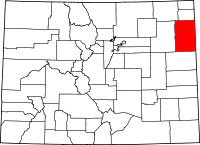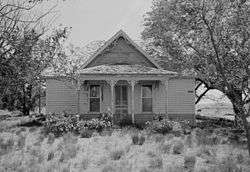Yuma County, Colorado
| Yuma County, Colorado | |
|---|---|
 Location in the U.S. state of Colorado | |
 Colorado's location in the U.S. | |
| Founded | March 15, 1889 |
| Seat | Wray |
| Largest city | Yuma |
| Area | |
| • Total | 2,369 sq mi (6,136 km2) |
| • Land | 2,364 sq mi (6,123 km2) |
| • Water | 4.3 sq mi (11 km2), 0.2% |
| Population (est.) | |
| • (2015) | 10,146 |
| • Density | 4.2/sq mi (2/km²) |
| Congressional district | 4th |
| Time zone | Mountain: UTC-7/-6 |
| Website |
www |

Yuma County is one of the 64 counties of the U.S. state of Colorado. As of the 2010 census, the population was 10,043.[1] The county seat is Wray.[2]
Geography
According to the U.S. Census Bureau, the county has a total area of 2,369 square miles (6,140 km2), of which 2,364 square miles (6,120 km2) is land and 4.3 square miles (11 km2) (0.2%) is water.[3]
The point where the Arikaree River flows out of Yuma County and into Cheyenne County, Kansas is the lowest point in the State of Colorado at 1,010 meters (3,315 feet) elevation. This crossing point holds the distinction of being the highest low point of any U.S. state.[4]
Adjacent counties
- Phillips County - north
- Chase County, Nebraska - northeast
- Cheyenne County, Kansas - east
- Dundy County, Nebraska - east
- Kit Carson County - south
- Washington County - west
- Logan County - northwest
Demographics
| Historical population | |||
|---|---|---|---|
| Census | Pop. | %± | |
| 1890 | 2,596 | — | |
| 1900 | 1,729 | −33.4% | |
| 1910 | 8,499 | 391.6% | |
| 1920 | 13,897 | 63.5% | |
| 1930 | 13,613 | −2.0% | |
| 1940 | 12,102 | −11.1% | |
| 1950 | 10,827 | −10.5% | |
| 1960 | 8,912 | −17.7% | |
| 1970 | 8,544 | −4.1% | |
| 1980 | 9,682 | 13.3% | |
| 1990 | 8,954 | −7.5% | |
| 2000 | 9,841 | 9.9% | |
| 2010 | 10,043 | 2.1% | |
| Est. 2015 | 10,146 | [5] | 1.0% |
| U.S. Decennial Census[6] 1790-1960[7] 1900-1990[8] 1990-2000[9] 2010-2015[1] | |||
As of the census[10] of 2000, there were 9,841 people, 3,800 households, and 2,644 families residing in the county. The population density was 4 people per square mile (2/km²). There were 4,295 housing units at an average density of 2 per square mile (1/km²). The racial makeup of the county was 94.17% White, 0.11% Black or African American, 0.28% Native American, 0.07% Asian, 0.02% Pacific Islander, 4.14% from other races, and 1.21% from two or more races. 12.88% of the population were Hispanic or Latino of any race.
There were 3,800 households out of which 33.30% had children under the age of 18 living with them, 59.60% were married couples living together, 6.80% had a female householder with no husband present, and 30.40% were non-families. 27.40% of all households were made up of individuals and 13.30% had someone living alone who was 65 years of age or older. The average household size was 2.55 and the average family size was 3.13.
In the county the population was spread out with 28.30% under the age of 18, 7.10% from 18 to 24, 26.00% from 25 to 44, 22.30% from 45 to 64, and 16.30% who were 65 years of age or older. The median age was 37 years. For every 100 females there were 96.80 males. For every 100 females age 18 and over, there were 94.90 males.
The median income for a household in the county was $33,169, and the median income for a family was $39,814. Males had a median income of $26,124 versus $18,578 for females. The per capita income for the county was $16,005. About 8.80% of families and 12.90% of the population were below the poverty line, including 15.50% of those under age 18 and 10.70% of those age 65 or over.
Communities
Cities
Town
Unincorporated communities
Ghost Towns
- Bryant
- Leslie
- Clarkville
- Ford
- Weld City
- Ladlum
- Waverly
- Arlene
- Arnold
- Schramm
- Heartstrong
- Happyville
- Hughes
- Avoca
- Fox
- Steffens
- Abarr
- Mildred
- Friend
- Wages
- Witherbee
- Wauneta
- Alvin
- Robb
- Condon
- Shields
- Bolton
- Rogers
- Newton
- Beecher
- Armel
- Hermes
- Lansing
- Gurney
- Logan
See also
- Outline of Colorado
- Index of Colorado-related articles
- National Register of Historic Places listings in Yuma County, Colorado
References
- 1 2 "State & County QuickFacts". United States Census Bureau. Retrieved February 11, 2014.
- ↑ "Find a County". National Association of Counties. Archived from the original on May 31, 2011. Retrieved 2011-06-07.
- ↑ "US Gazetteer files: 2010, 2000, and 1990". United States Census Bureau. 2011-02-12. Retrieved 2011-04-23.
- ↑ U.S. Geological Survey. "Elevations and Distances". Retrieved 2006-09-08.
- ↑ "County Totals Dataset: Population, Population Change and Estimated Components of Population Change: April 1, 2010 to July 1, 2015". Retrieved July 2, 2016.
- ↑ "U.S. Decennial Census". United States Census Bureau. Archived from the original on May 11, 2015. Retrieved June 11, 2014.
- ↑ "Historical Census Browser". University of Virginia Library. Retrieved June 11, 2014.
- ↑ "Population of Counties by Decennial Census: 1900 to 1990". United States Census Bureau. Retrieved June 11, 2014.
- ↑ "Census 2000 PHC-T-4. Ranking Tables for Counties: 1990 and 2000" (PDF). United States Census Bureau. Retrieved June 11, 2014.
- ↑ "American FactFinder". United States Census Bureau. Archived from the original on September 11, 2013. Retrieved 2011-05-14.
External links
- Yuma County Government website
- Yuma County farm photos and documentation, from Historic American Buildings Survey
- Colorado County Evolution by Don Stanwyck
- Colorado Historical Society
 |
Logan County | Phillips County | Chase County, Nebraska |  |
| Washington County | |
Dundy County, Nebraska and Cheyenne County, Kansas | ||
| ||||
| | ||||
| Kit Carson County |
Coordinates: 40°00′N 102°25′W / 40.00°N 102.42°W
